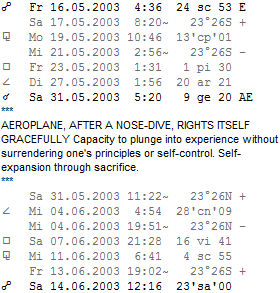
| What Watch? - Tutorial | Next chapter: Solar Return and Persona Charts | Back to First Page |
Following Lunation Cycles
A lunation between two new moons is the most popular astrological cycle, and one of the most important. What Watch allows you to follow it closely.
 |
Let's start with a practical question: when is the next new moon? On the top panel, change the calculation mode to "Mundane", select Sun as "Slower" and Moon as "Faster" planet and press "List". Of course, you can also use the shortcut button in the top panel of What Watch ... You get a list where conjunctions mark new moons and oppositions full moons. The other moon phases are shown as well, and you can also see when the moon is out of bounds, ie moving beyond the ecliptic. Click on one of the lines, and the Sabian symbol for the corresponding degree will be shown. The example on the left shows a new moon on 31/5, with its Sabian symbol of 10° gemini. |
If you want to delve deeper into a chart, right click on the corresponding line of the transit list. If you are working on chart "One", the transit chart is loaded into tab "Two", and vice versa. You can work with it like with any other chart.
Progressions
You can also apply the lunation technique to progressed movements.
These are based on the assumption that, symbolically, a year equals a day.
Therefore, a progressed lunation cycle takes about 29 and a half years to complete.
It is one of life's major cycles, and it marks its great rhythms, from new
beginnings to the ends that are due.
|
For calculating progressed lunation cycles in What Watch, reactivate the "Birthchart" mode on the top panel. Choose "Progressed Sun" as Birth Planet, "Progressed Moon" as Transit planet and press "List". The result is a transit list as the one described above, including Sabian symbols and full transit charts. |
 |
To find the phases of the cycle, find the first conjunction, or progressed new moon. The next semisquare marks the beginning of the crescent phase, at the square starts the first quarter, the gibbeous phase is at the sesquiquadrate and so on.
Finally, let's look at the movement of the progressed moon through the natal houses, an indicator of the realms in which the progressed moon will manifest itself. Again, What Watch allows to quickly generate a transit list that will give you the key dates. Select "All Houses" as Birth Planet, keep the Progressed Moon as Transit planet, press "List", and you're done.
Eclipses
Some new moons form a solar eclipse, and some full moons lunar ones. Eclipses
are marked in the list. The new moon of 31/5 was an annular solar eclipse somewhere
on the globe. If you load the chart and go to the geography module, the yellow
marker is placed exactly in the center of the eclipse at that time. Two weeks
before, on 16/5, there was a total lunar eclipse. Total eclipses are marked
by "E", partial eclipses by "PE", annular solar eclipses
by "AE" and penumbral lunar eclipses by "PeE".
Eclipses follow a regular pattern that was known already in antiquity: the Saros cycle. Every 18 years 11 days and 8 hours there is an eclipse belonging to a series that shares the same geometrical characteristics. You'll find the corresponding data on the NASA website quoted below.
Literature:
Dane Rudhyar - The Lunation Cycle, Aurora Press: Santa Fe NM 1986
Dane Rudhyar - Sabian Symbols, in: The Astrology of Personality, Aurora Press: Santa Fe NM 1991
Steven Forrest - The Book of the Moon, Seven Paws Press: Borrego Springs CA 2010
Steven Forrest - The Progressed Moon through the Houses, in: Green/Forrest - Measuring the Night, Vol. 2,
Seven Paws Press & Daemon Press, 2001
Very detailed data on eclipses: http://eclipse.gsfc.nasa.gov/eclipse.html (from NASA's
Goddard Space Flight Center)
| What Watch? - Tutorial | Next chapter: Solar Return and Persona Charts | Back to First Page |